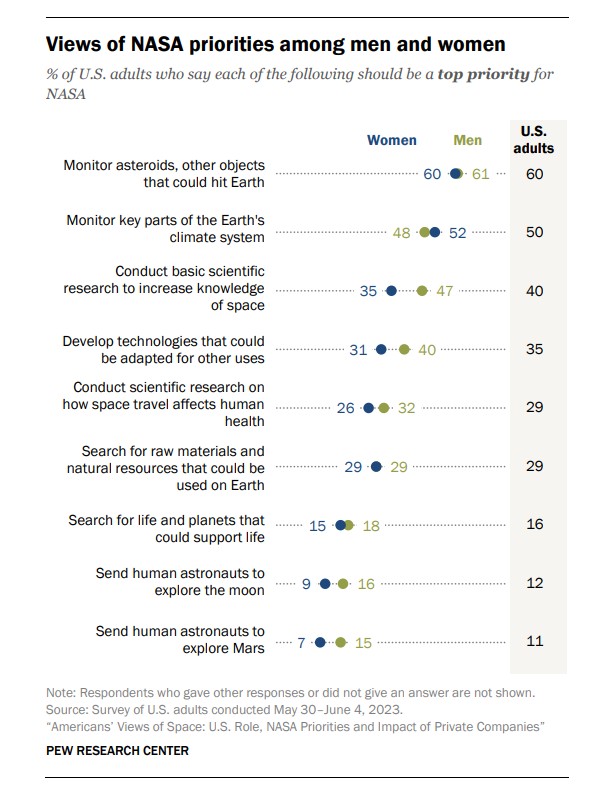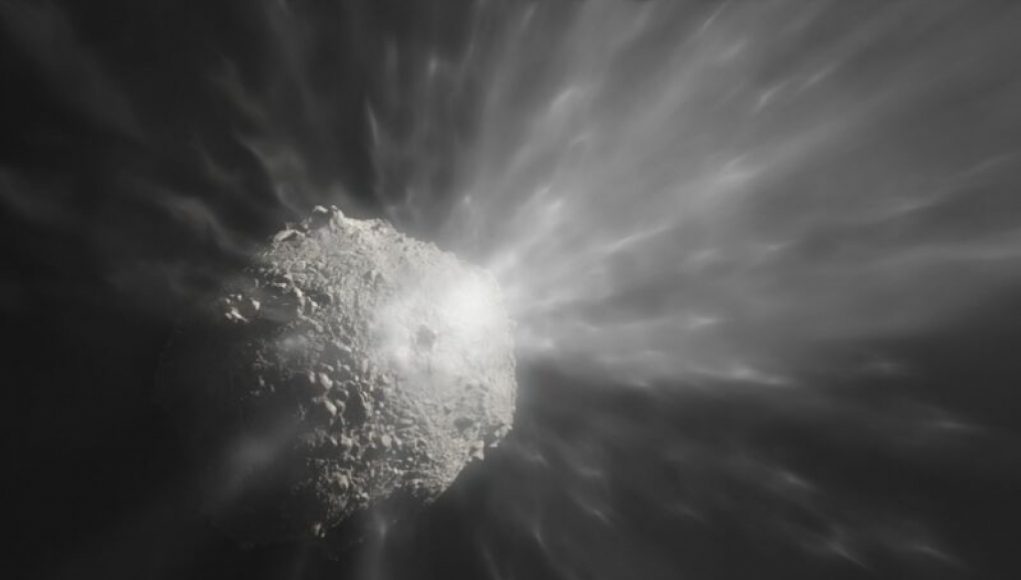The Pew Research Center published the results of a new public survey on Thursday, the 54th anniversary of the Apollo 11 landing on the Moon. The survey assessed Americans’ attitudes toward space exploration and space policy issues.
Excitingly, the survey found that Americans overwhelmingly support the national space agency, NASA. In fact, three-quarters of respondents had a favorable opinion of NASA, compared to just 9 percent with an unfavorable opinion.
However, as several previous surveys have shown, the public has different priorities for NASA than what is reflected in the space agency’s budget. In this new report, based on a large survey of 10,329 US adults, the highest support came for “monitoring asteroids and other objects that could hit the Earth” (60 percent) and “monitoring key parts of the Earth’s climate system” (50 percent). Sending astronauts to the Moon (12 percent) and Mars (11 percent) were much lower on the list of priorities for respondents.
Interestingly, support for deep space exploration by humans was particularly low among women. Only 9 percent of female respondents listed sending humans to the Moon as a “top priority” for NASA, and just 7 percent of women said the same about sending humans to Mars.

These priorities sharply contrast with the funds NASA actually allocates to exploration. For example, in fiscal year 2024, NASA has requested $210 million from Congress to continue developing the Near-Earth Object Surveyor mission. This mission, planned for launch in 2028, aims to detect, track, and study impact hazards from asteroids and comets. NASA also plans to spend approximately $2.5 million on Earth Science missions.
Meanwhile, the space agency has asked for about $8 billion to fund its ongoing Artemis program missions next year, which include rockets, spacecraft, and landers, with the goal of enabling a human landing on the Moon later this decade. NASA officials believe that the Artemis program will provide valuable knowledge and techniques that will eventually allow astronauts to journey to Mars in the 2030s or 2040s.
Advertisement
Protect the planet
Despite this disparity, NASA has intensified its efforts in planetary defense. Less than a decade ago, the space agency allocated less than $50 million annually to detect and track potentially hazardous asteroids, issue notices and warnings of possible impacts, and coordinate planning and response across US government agencies.
In November 2021, in collaboration with the European Space Agency, NASA took a significant step forward with the launch of the Double Asteroid Redirection Test mission. This mission intercepted a near-Earth asteroid and successfully impacted a small asteroid in 2022, demonstrating NASA’s ability to potentially divert an incoming asteroid if a threat is identified.
Overall, these survey results reinforce the idea that while public support for NASA is widespread, it is not necessarily deep, especially when it comes to human space exploration. The areas where NASA allocates the majority of its funding are the ones that the public seems to be least interested in, at least according to surveys. So, what does this mean for space policy?
For a long time after the Apollo program, NASA and space policy leaders hoped for another era of strong support and a larger budget for space exploration. In the 1960s, NASA’s budget reached about 5 percent of federal spending. Today, it stands at around 0.5 percent. Space enthusiasts often imagine what could be accomplished if NASA’s budget were to double or triple.
However, those days are unlikely to return. The US public appreciates NASA, astronauts, and the exciting events that occur in space. But their priorities are primarily focused on Earth. As Phil Larson, a key space policy official at the Johns Hopkins Applied Physics Lab, once said, “The vast majority of the public thinks that we should have a space program that saves Earth.”
To NASA’s credit, the space agency seems to have recognized this. Instead of aiming for the Moon with a significantly larger budget, NASA has fostered a commercial space industry. Through public-private partnerships in lunar landers, spacesuits, and other activities, NASA is finding ways to align its deep-space exploration plans with its current budget from the federal government. NASA has also made it a priority to land the “first woman on the Moon” during the next human mission. Perhaps this will garner broader support for lunar exploration in future surveys.
The world has taken a deep interest in extraterrestrial threats as of late, and the United States has taken the lead. Despite their other ambitious goals, the US public is steering NASA back to its roots: planetary defense.
The need for asteroid defense systems has become apparent since 2019 when an asteroid the size of a ten-story apartment building narrowly missed a catastrophic impact with the Earth. Scientists have since found several more of these close-approaching asteroids, some of which are large enough to cause significant destruction if an impact was to occur.
To counter this, US lawmakers have been pushing for funding to NASA for an effective planetary defense system. This system would be comprised of satellites, telescopes, and probes to detect any near-Earth objects that could cause destruction, along with components to deflect an incoming object, if needed.
The public is following these proceedings closely, citing that if there is a lack of emphasis placed on asteroid defense over exploration, it will put the entire planet at risk. After the United Nations passed a resolution last year declaring the need to increase efforts to prevent asteroid impacts, the US public came out in full force. Organizations such as the B612 Foundation have led the charge, urging that the federal government take the necessary steps to ensure a necessary level of protection.
Though planetary exploration is undoubtedly important for scientific advancement, the US public insists that asteroid defense should be given the highest priority. They argue that the money spent to explore other planets and galaxies could be better allocated to protect the home planet from potential asteroids.
It is clear that a sense of urgency exists when it comes to asteroid defense. The US public is pressing NASA and Congress to make planetary defense a top priority and to increase funding for research into combating potential cosmic impacts, rather than wasting money and resources on other pursuits. Hopefully, the government will respond with the proper actions soon, to allow for a safer future for everyone.




















